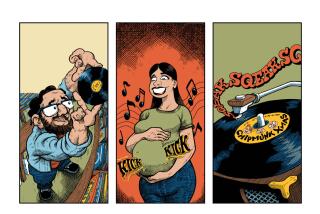Digital Tape Creates Wave of Excitement, Controversy : Recording Industry Up in Arms Over New Technology
- Share via
LAS VEGAS — Let’s get digital.
That was the buzzword racing through the Consumer Electronics Show here last week, as manufacturers demonstrated prototype machines capable of a controversial new technology--digital audio tape, or DAT.
Just three years after compact disk players started changing the audio purchases and habits of millions of Americans, Japanese companies are preparing to introduce a technology that offers the high-quality sound of laser-read CDs with an important bonus. Unlike CDs, which can only be played back, digital audio tape can be used to record digitally and avoid the background noise and imprecisions inherent in the current method of analog recording used on long-playing records and audiocassettes.
The prospect of DAT has caused an uproar in the recording industry, which has two major concerns: that the relatively fledgling compact disk technology will stumble if consumers start clamoring for the latest toy and that recording artists will suffer lost royalties (and record companies, lost sales) if consumers find that they can use the new technology to make their own high-quality recordings.
Meeting Produced Stalemate
A DAT meeting last month in Vancouver, British Columbia, between hardware manufacturers and record industry executives ended in a stalemate, but record companies continued to lean on manufacturers not to bring out the equipment unless it contained anti-copying devices.
To that, Sony and a handful of other companies at the three-day electronics show said, “Bunk.”
At Sony’s big, central booth, a prominently displayed prototype model drew impressive--and impressed--crowds. “We’re showing our technology,” said Neil R. Vander Dussen, president and chief operating officer of Sony Corp. of America, in an interview. “It’s creating a great deal of interest on the floor.”
That was perhaps the only major understatement of the show, where the 100,000 participants had little else new to pique their interest. In addition to Sony, Onkyo, Kenwood and Alpine openly demonstrated component or car units in their booths.
Other companies, however, decided not to flaunt it even if they had it--and even though most companies had demonstrated prototypes at a Tokyo trade show in October. At Casio, a representative led a reporter into a tiny locked room with steel-gray walls and a few chairs and said, “There it is.” And there the DAT machine was, atop a cabinet and covered with a piece of black fabric.
At a suite in the Las Vegas Hilton, JVC officials gave retailers and other guests a private hearing of DAT away from the hubbub of the convention floor. When a request was made to see Hitachi’s machine, an official said the company had decided to honor a last-minute request by the Electronic Industries Assn. of Japan not to demonstrate DAT.
Controversy Spurs Excitement
Gerald J. (Gerry) Ghinelli, marketing manager for Maxell, a tape maker, said the air of mystery created by the record industry’s “prohibition” on DAT was having the opposite of its intended effect. “The controversy is creating more excitement, which will compel release of the product,” he said, adding: “You can’t institute roadblocks to the competitive marketplace.” Maxell, Fuji and TDK were among the tape makers promoting the technology, which uses tapes about half the size of standard audiocassettes.
Underscoring the controversy, Denon America, a pioneer in digital recording with hardware, took the unusual step of issuing a press release saying it would not display DAT. “We have to be rational about this,” said Ken Furth, general manager. “It would be premature to bring it out. We’re not saying we don’t want to see DAT ever. We’re just afraid to see it be stillborn before the market’s ready.”
Even so, he acknowledged that the company, which makes both audio hardware and recordings, “could throw the switch tomorrow and start making DAT.”
And that was basically the case at most other companies, which said they could ship equipment possibly as early as late summer or early fall, once the industry agreed on standards and gave the go-ahead.
Even when DAT equipment hits the market--and most companies say that’s inevitable by year-end--its primary audience is likely to be limited to well-to-do audiophiles. The machines are expected to run about $1,000, and manufacturers warn that the price tags aren’t likely to come down quickly--as they did with compact disk equipment--because of the machines’ complexity. The blank tape won’t exactly be a bargain, either, at $8 to $25 per cassette.
Japan’s Big Stake
Given the consumer electronics industry’s cutthroat nature and the dollar’s decline against the yen, the Japanese have a big stake in this new technology. Pressure on profit margins has prompted companies to cut corners elsewhere--on advertising and overhead. But with high-priced DAT equipment, they just might recoup some of what they’ve lost on the bottom line.
Meanwhile, the Electronic Industries Assn., the trade group that sponsors the trade show, is pleased to see the DAT juices flowing and believes that the record companies’ fears will ultimately prove unfounded.
“When audiocassettes were first introduced, they were greeted by the major record companies with boos,” said Frank Myers, the group’s vice president, in a speech at the show. “When the CD was introduced, the same negative chorus greeted its entrance. The CD would destroy the market for LPs and cassettes. An expensive plaything for a few fanatics, right? Wrong, of course.” About DAT, Myers urged: “Let the marketplace decide.”







